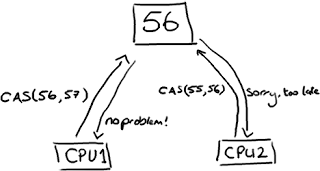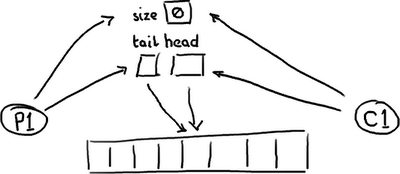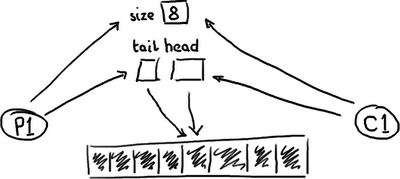Dissecting the Disruptor: Why it’s so fast (part one) – Locks Are Bad
The thing about locks is that they need the operating system to arbitrate the argument. The threads are like siblings squabbling over a toy, and the OS kernel is the parent that decides which one gets it. It’s like when you run to your Dad to tell him your sister has nicked the
I’m just touching the surface of the problem, and obviously I’m using very simple examples. But the point is, if your code is meant to work in a multi-threaded environment, your job as a developer just got a lot more difficult:
- Naive code can have unintended consequences.Case Three above is an example of how things can go horribly wrong if you don’t realise you have multiple threads accessing and writing to the same data.
- Selfish code is going to slow your system down. Using locks to protect your code from the problem in Case Three can lead to things like deadlock or simply poor performance.
This is why many organisations have some sort of concurrency problems in their interview process (certainly for Java interviews). Unfortunately it’s very easy to learn how to answer the questions without really understanding the problem, or possible solutions to it.
How does the Disruptor address these issues?
For a start, it doesn’t use locks. At all.
Instead, where we need to make sure that operations are thread-safe (specifically, updating the next available sequence number in the case of multiple producers), we use a CAS (Compare And Swap/Set) operation. This is a CPU-level instruction, and in my mind it works a bit like optimistic locking – the CPU goes to update a value, but if the value it’s changing it from is not the one it expects, the operation fails because clearly something else got in there first.

Note this could be two different cores rather than two separate CPUs.
CAS operations are much cheaper than locks because they don’t involve the operating system, they go straight to the CPU. But they’re not cost-free – in the experiment I mentioned above, where a lock-free thread takes 300ms and a thread with a lock takes 10,000ms, a single thread using CAS takes 5,700ms. So it takes less time than using a lock, but more time than a single thread that doesn’t worry about contention at all.
Back to the Disruptor – I talked about the ClaimStrategy when I went over the producers. In the code you’ll see two strategies, a SingleThreadedStrategy and a MultiThreadedStrategy. You could argue, why not just use the multi-threaded one with only a single producer? Surely it can handle that case? And it can. But the multi-threaded one uses an AtomicLong (Java’s way of providing CAS operations), and the single-threaded one uses a simple long with no locks and no CAS. This means the single-threaded claim strategy is as fast as possible, given that it knows there is only one producer and therefore no contention on the sequence number.
I know what you’re thinking: turning one single number into an AtomicLong can’t possibly have been the only thing that is the secret to the Disruptor’s speed. And of course, it’s not – otherwise this wouldn’t be called “Why it’s so fast (part one)”.
But this is an important point – there’s only one place in the code where multiple threads might be trying to update the same value. Only one place in the whole of this complicated data-structure-slash-framework. And that’s the secret. Remember everything has its own sequence number? If you only have one producer then every sequence number in the system is only ever written to by one thread. That means there is no contention. No need for locks. No need even for CAS. The only sequence number that is ever written to by more than one thread is the one on the ClaimStrategy if there is more than one producer.
This is also why each variable in the Entry can only be written to by one consumer. It ensures there’s no write contention, therefore no need for locks or CAS.
Back to why queues aren’t up to the job
So you start to see why queues, which may implemented as a ring buffer under the covers, still can’t match the performance of the Disruptor. The queue, and the basic ring buffer, only has two pointers – one to the front of the queue and one to the end:

If more than one producer wants to place something on the queue, the tail pointer will be a point of contention as more than one thing wants to write to it. If there’s more than one consumer, then the head pointer is contended, because this is not just a read operation but a write, as the pointer is updated when the item is consumed from the queue.
But wait, I hear you cry foul! Because we already knew this, so queues are usually single producer and single consumer (or at least they are in all the queue comparisons in our performance tests).
There’s another thing to bear in mind with queues/buffers. The whole point is to provide a place for things to hang out between producers and consumers, to help buffer bursts of messages from one to the other. This means the buffer is usually full (the producer is out-pacing the consumer) or empty (the consumer is out-pacing the producer). It’s rare that the producer and consumer will be so evenly-matched that the buffer has items in it but the producers and consumers are keeping pace with each other.
So this is how things really look. An empty queue:

…and a full queue:

The queue needs a size so that it can tell the difference between empty and full. Or, if it doesn’t, it might determine that based on the contents of that entry, in which case reading an entry will require a write to erase it or mark it as consumed.
Whichever implementation is chosen, there’s quite a bit of contention around the tail, head and size variables, or the entry itself if a consume operation also includes a write to remove it.
On top of this, these three variables are often in the same cache line, leading to false sharing. So, not only do you have to worry about the producer and the consumer both causing a write to the size variable (or the entry), updating the tail pointer could lead to a cache-miss when the head pointer is updated because they’re sat in the same place. I’m going to duck out of going into that in detail because this post is quite long enough as it is.
So this is what we mean when we talk about “Teasing Apart the Concerns” or a queue’s “conflated concerns”. By giving everything its own sequence number and by allowing only one consumer to write to each variable in the Entry, the only case the Disruptor needs to manage contention is where more than one producer is writing to the ring buffer.
In summary
The Disruptor a number of advantages over traditional approaches:
- No contention = no locks = it’s very fast.
- Having everything track its own sequence number allows multiple producers and multiple consumers to use the same data structure.
- Tracking sequence numbers at each individual place (ring buffer, claim strategy, producers and consumers), plus the magic cache line padding, means no false sharing and no unexpected contention.
